If you are thinking of a culinary career or are already confident that this is what you want to do, this article is for you. When our son showed an interest in a culinary career, we knew very little about the field at the time, and like him, we had many questions.
We did research, and many of our queries are in this article, along with ones a potential culinary student or their parents may have. We primarily gathered information by speaking to chef instructors and culinary students. We hope you find it helpful.
What is a culinary student?
A culinary student studies culinary arts at a culinary school to become skilled in cooking or baking and master the essentials of operating and managing the kitchen of a food establishment.
The role of the culinary student is to dedicate themselves to learning the theory and practice of cooking or baking and kitchen operations. They need to meet the requirements of their culinary training program so that they can more easily transition to the real-life culinary work environment.
What is a culinary student called?
A culinary student is called a commis chef as they are chefs in training and learn the basics of food preparation, cooking, and kitchen operations.
When culinary students start their first jobs in a commercial kitchen, they are, even then, known as commis chefs as they still have many essential culinary skills to learn.
What is the role of a culinary school?
A culinary school is a learning-based institution devoted to training culinary students in the art of professional cooking and patisserie (pastry and baking) and awarding students with accredited culinary qualifications.
Many culinary school programs consist of two parts:
1. On-site training at the culinary school of choice.
2. Off-site training in a commercial kitchen
The first occurs at the culinary school, where students receive theoretical knowledge and practical skills in food preparation, cooking and presentation. Included is any additional academic and practical support where learning gaps in the culinary student’s training have been identified.
This first training phase is in preparation to transition into the second apprenticeship, part of the training. Here learners work in a commercial kitchen, learning from and gaining experience while working and being supervised by skilled chefs. With this well-rounded education, learners transition with greater ease into the workplace.
A culinary education goes beyond the technical training to include the soft skills needed to work well in the real world and have skills like managing time, working under pressure, discipline, working long hours, following instructions, respecting the kitchen line of command, and adjusting to criticism.
The culinary skills that a student learns at culinary school also include things like:
- Understanding the hospitality, tourism, and catering world.
- The importance of kitchen and food hygiene and safety.
- The importance of personal hygiene and safety.
- Understanding the importance of kitchen procedures.
Is it necessary to go to culinary school?
Attending culinary school is recommended but not strictly necessary to become a culinary or patisserie chef. Some chefs do on-the-job training, starting by washing dishes and working their way up in the kitchen.
There are several advantages to attending culinary school. For one, you get to train under various chefs with vast experience. In addition, you may be more eligible for the job market with a recognised qualification from a known culinary school.
There are also disadvantages to attending culinary school, like the high cost of training. Evaluate the pros and cons of attending culinary school before deciding. It is a personal choice and should depend on several personal considerations like your unique personality style or the learning environment that best suits you.
How do you get into culinary school?
To get into a culinary school, you must be 18 years or older, have a recognised school leavers certificate, and meet the grade and subject requirements of the culinary school of your choice. Proficiency in the language of instruction is essential.
As entry requirements may vary across schools, ensure that you meet the specific needs of your school of interest. The criteria for entry into a culinary school generally relate to age, end-of-school qualifications, and subject choice.
Do I need to know how to cook to attend culinary school?
You do not have to know how to cook to attend culinary school, although it is an advantage. You will learn the basics of food preparation, cooking, and food presentation at culinary school.
In the course our son pursued, several students had little or no experience with cooking, while others had worked in restaurant kitchens or cooked at home. Naturally, this experience is beneficial as it makes you more comfortable and confident in the kitchen, but you will learn all that at culinary school.
How do I know if I’m suited for a culinary career?
You know you are suited to a culinary career if your first passion is working with food. You don’t mind being on your feet for many hours to cook, create new dishes, and serve them in aesthetically pleasing ways that bring satisfaction to others, as this motivates and fulfils you.
When attending a welcome evening for parents at our son’s culinary school, we listened to chef Jonathan Moreno, a prominent executive chef with global experience, share his story. After more than twenty years in the culinary world, his eyes still glow when he talks about his love for cooking. That’s passion!
Here’s a list of qualities indicating suitability for a culinary career. Rate yourself according to what you mostly have or not and may need to develop for a culinary career. It is not a formal assessment. If you feel you need a career assessment, it may be best to contact a career counsellor.
| Indicators for suitability for a culinary career. | I mostly have this quality. | I mostly don’t have this quality. |
|---|---|---|
| A drive and passion for cooking or working with food. | ||
| Find joy and fulfilment in cooking for others. | ||
| A creative inclination for experimenting with food. | ||
| High energy and physical stamina to stand on feet, working for long hours at a time. | ||
| Don’t mind working under pressure and time limits. | ||
| A disciplined worker | ||
| Ability to pay attention to detail | ||
| Tendency to work in a planned and organised way. | ||
| Strong mental mindset and resilience to bounce back quickly from stressful situations. | ||
| Not overly sensitive to criticism. | ||
| Able to think on your feet and solve problems. | ||
| You don’t mind working in a team and are willing to learn to work with different personalities. |
Be careful, though, when looking at these qualities. They may not all apply to you. Your ambition may, for example, be to use your culinary education in a career in food photography rather than work in a restaurant.
How do you find the right culinary school?
With an ever-increasing number of culinary schools that have emerged worldwide in recent years, you must know how to find one that is right for you.
To find the best culinary school for you, research a few schools and ensure the one you decide on has the proper credentials and is accredited by the appropriate quality assurance bodies in your country. These bodies vet culinary school training programs, ensuring that specific standards are met.
As this is an important decision, we’ve written detailed guidelines on how to find the best culinary school that you can have a look at.
What is the difference between a culinary and a patisserie student?
As the term culinary means working with food, a culinary student trains in the art of hot (cooking) or cold (baking) food preparation or both. A patisserie student focuses on cold food preparation, learning to bake, work with pastry and prepare desserts.
A commercial kitchen has two sections: the hot kitchen and the patisserie or cold kitchen.
In the hot kitchen, you deal with your starters and your main dishes, whereas in patisserie, you work with cakes and doughs, tarts, cold desserts, basically mostly sweet things.
Desserts are done in the pastry kitchen as the hot kitchen is way too hot to do desserts, whereas the temperature in a cold kitchen is suited to desserts and cakes.
What do culinary students wear at culinary school?
Culinary students wear their chef’s uniform to culinary school during their training. The uniform is referred to as chef whites and has five components from head to toe: chef hat, necktie, jacket, apron, and steel tip shoes. Gloves can also be worn.
At the onset of training, a culinary school provides each student with a uniform set or two, with the branding of the culinary school. This is part of the beginner pack that many culinary schools offer.
Wearing the chef’s uniform at culinary school is essential because:
- It is a requirement for working in the kitchen. The more significant portion of culinary training takes place in the culinary school lab kitchen; without it, a student is not allowed to enter the kitchen.
- It helps to protect from injury and keeps the student’s clothes clean from food or liquid spills during the kitchen labs. The kitchen, especially a busy one, can be dangerous with hot oil splashes, hot food falling, or accidents like slipping on a wet surface, for example. As culinary students are generally new to working in a busy kitchen environment, the risk of injury can be high.
- Wearing the uniform is the standard practice in the culinary industry. By wearing it to culinary school, the student becomes accustomed to doing so. They are thus prepared for what is expected when doing their workplace training.
- It inculcates a sense of professionalism and pride in being a chef.
- Working in a kitchen is about teamwork, and wearing the uniform, helps to foster a sense of camaraderie amongst the students.
A chef’s uniform is designed to meet specific hygiene and safety requirements and is made of robust fabric that is also light to wear.
Of course, knowing how to clean and maintain your chef uniform is essential, particularly the white chef coat. A clean and well-cared-for uniform is good for the chef image you want to present.
However, it can be challenging to keep your uniform clean as it is bound to get dirty from working in the kitchen. Hence, we have written an extensive article on how to clean and care for 1. your white chef coat and 2. your complete chef uniform and encourage you to read it.
Chef’s uniform: Description and purpose of components:
| Uniform Component | Description | Usefulness | |
|---|---|---|---|
| Chef hat: | 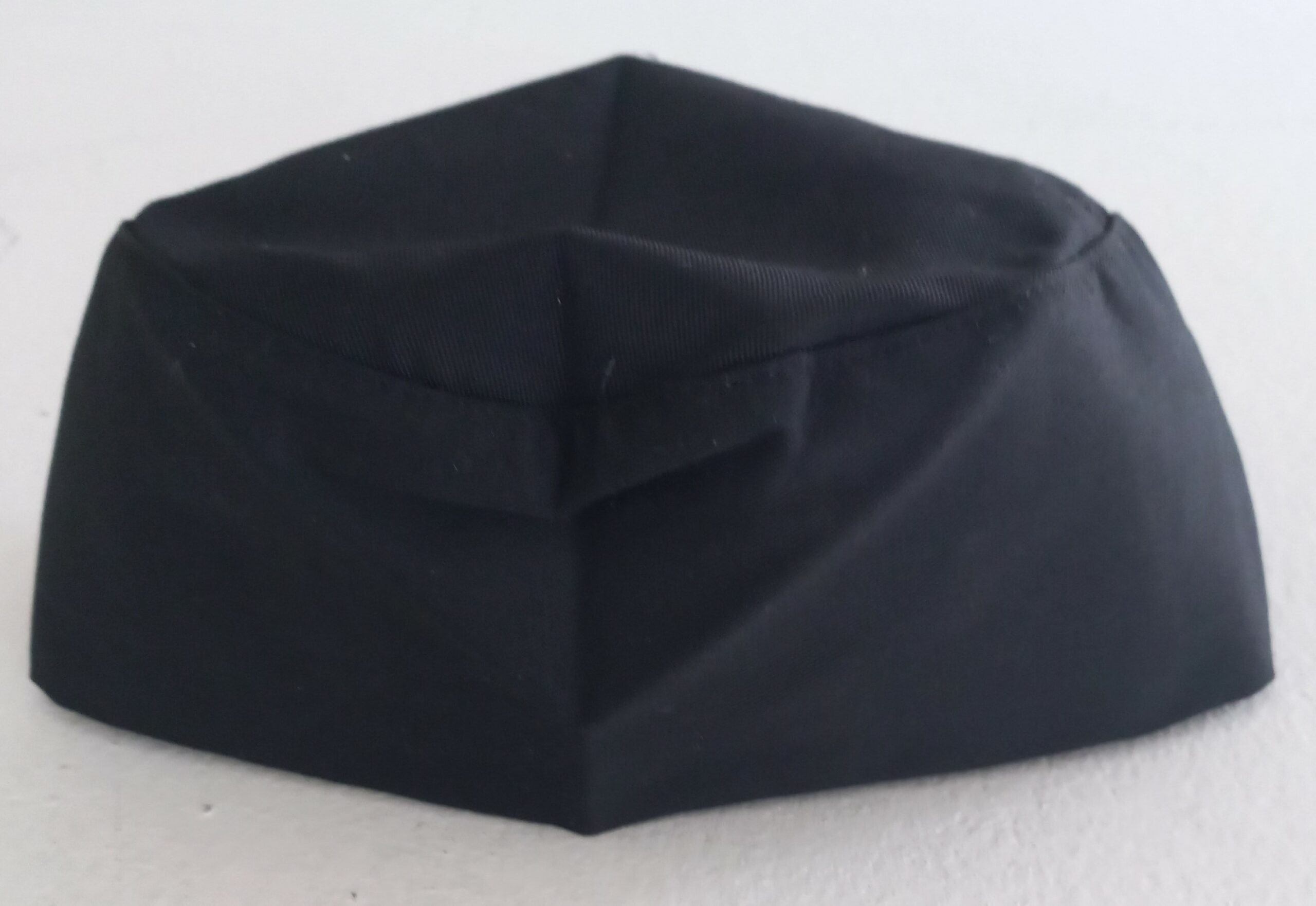 | Includes either the traditional white hat that looks like a pot without handles or a skull cap that looks like a saucepan with no handles. A hairnet is also worn. | Absorbs perspiration. It prevents loose hair strands from falling into food. |
| Chef jacket/coat: | A double-breasted long-sleeve jacket with a considerable overlap at the front and two sets of buttons. | Protects arms and chest from heat and burns from hot food, liquid spills, and splashes. Easy to rip off in cases of hot spills like boiling water. | |
| Chef pants: | 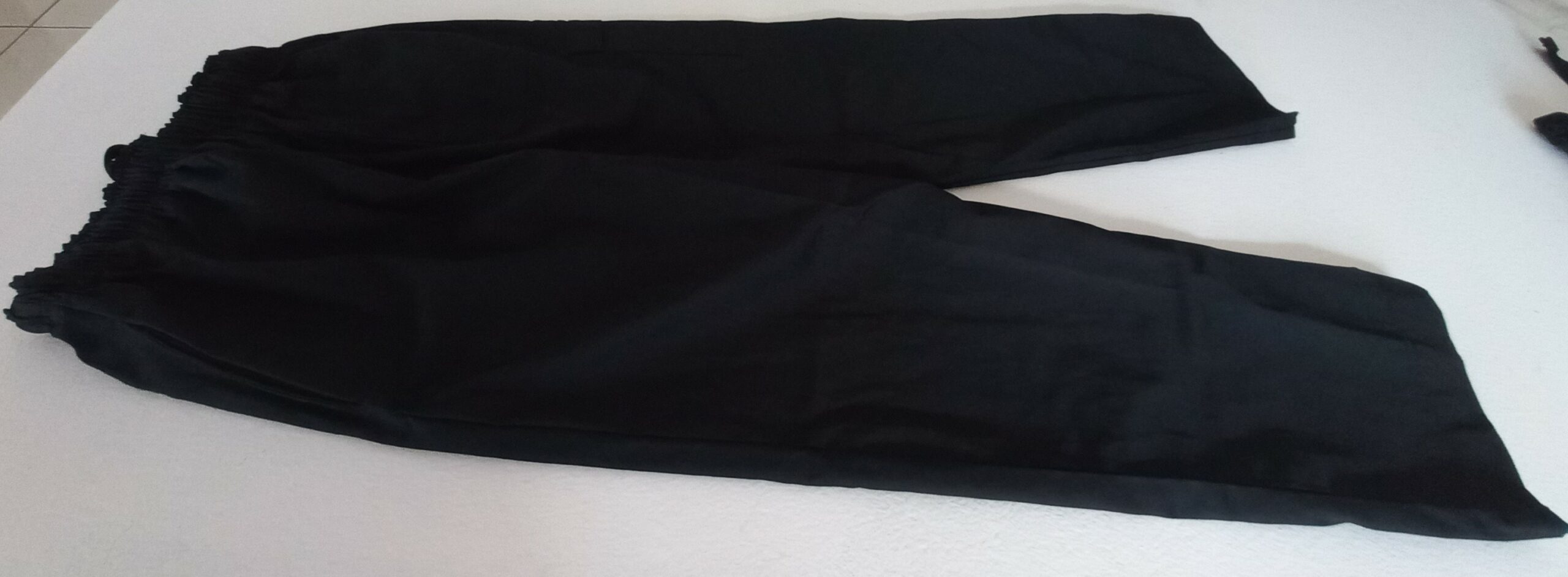 | Usually black or white and black checkered pants. | To keep your legs protected from oven or stove heat as well as from spills. |
| Chef apron: | 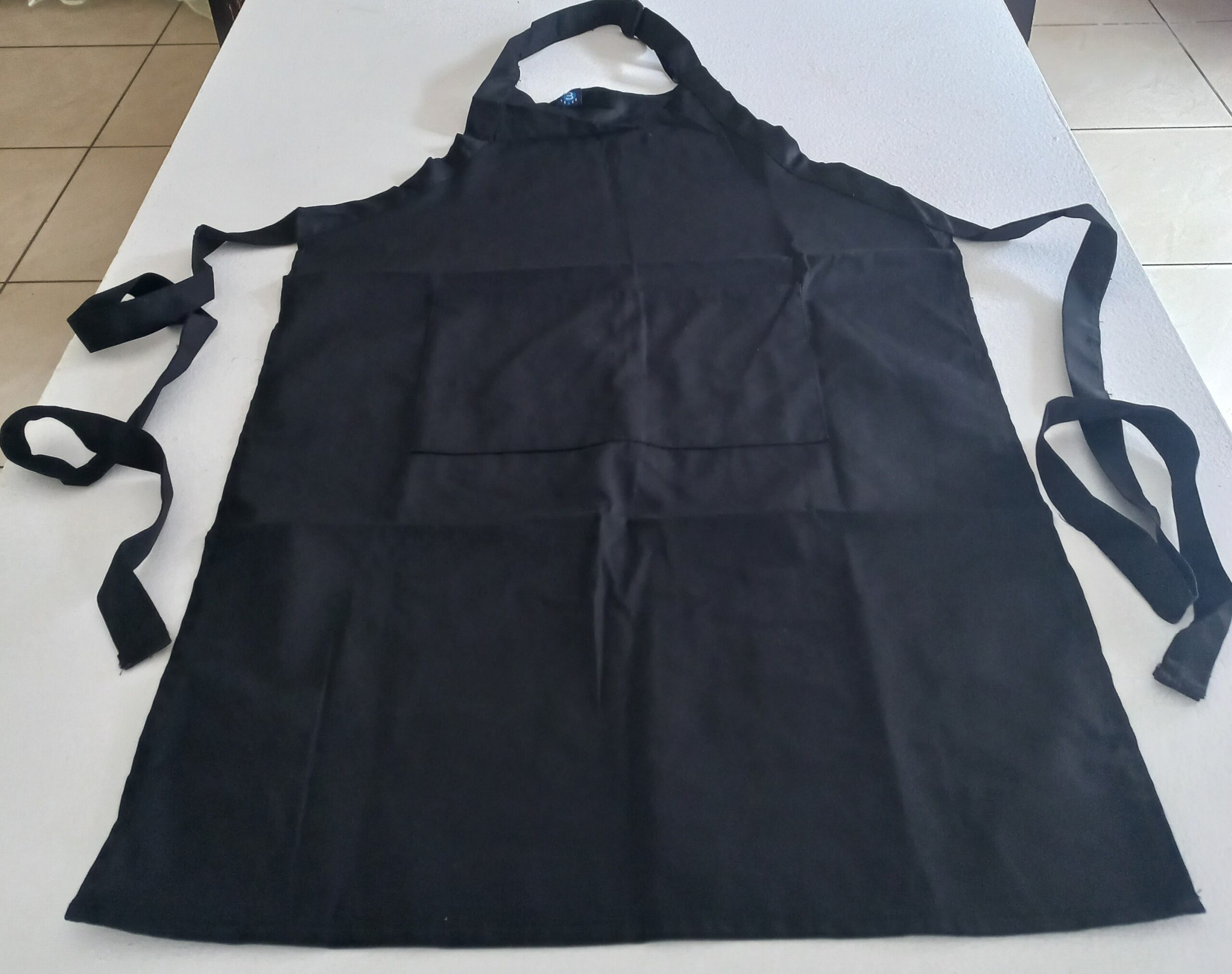 | Worn over chef’s jacket It must be long enough to cover the legs. | Protects chest and legs from hot food spills—aids in keeping the chef’s jacket clean. |
| Chef shoes: | Usually closed, non-slip shoes with metal tips inside and rubber soles. | Supports feet for the long hours of standing. Protects feet from spills, knives or pots falling. Prevents slipping. | |
| Chef gloves: | It is made of rubber. | Prevents food contamination, in cases of cuts, for example. Also, for plating so as not to leave fingerprints. |
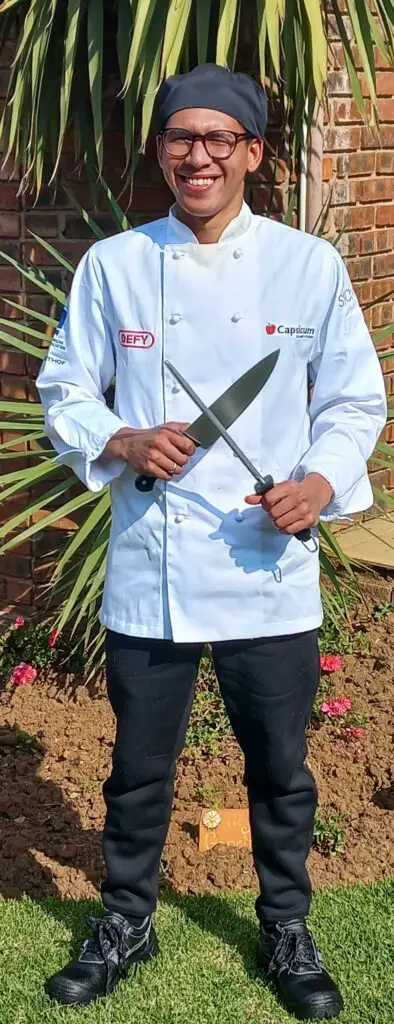
What equipment does a culinary student need?
The essential equipment that a culinary student needs is usually included in a culinary school’s starter kit to the student and can consist of:
- The chef’s uniform
- A set of student knives
- Sharpening steel
- Case for carrying knives
- One vegetable peeler
- Textbooks.
While there are other utensils for measuring, preparing, and cooking food, these don’t have to be purchased immediately and are available in the lab kitchen.
What knives do you use at culinary school?
At culinary school, you use three essential knives: a chef’s knife or chef’s, a paring knife, a boning knife, serrated bread knife. Each knife looks, feels, and has a different use:
| Name of knife | Description | Specific purpose |
| Chef’s knife | Also known as a French knife. | Used for general cutting and chopping |
| Paring knife | Also known as a vegetable knife. It’s more compact and easier to travel with. | Used for peeling and fine slicing vegetables, which would not be easy to do with a chef’s knife. For decorating and cutting shapes |
| Bread knife | Also called a serrated knife. | Used for cutting and slicing bread and baked items. The chef’s knife, used for so much, can’t be used for bread. |
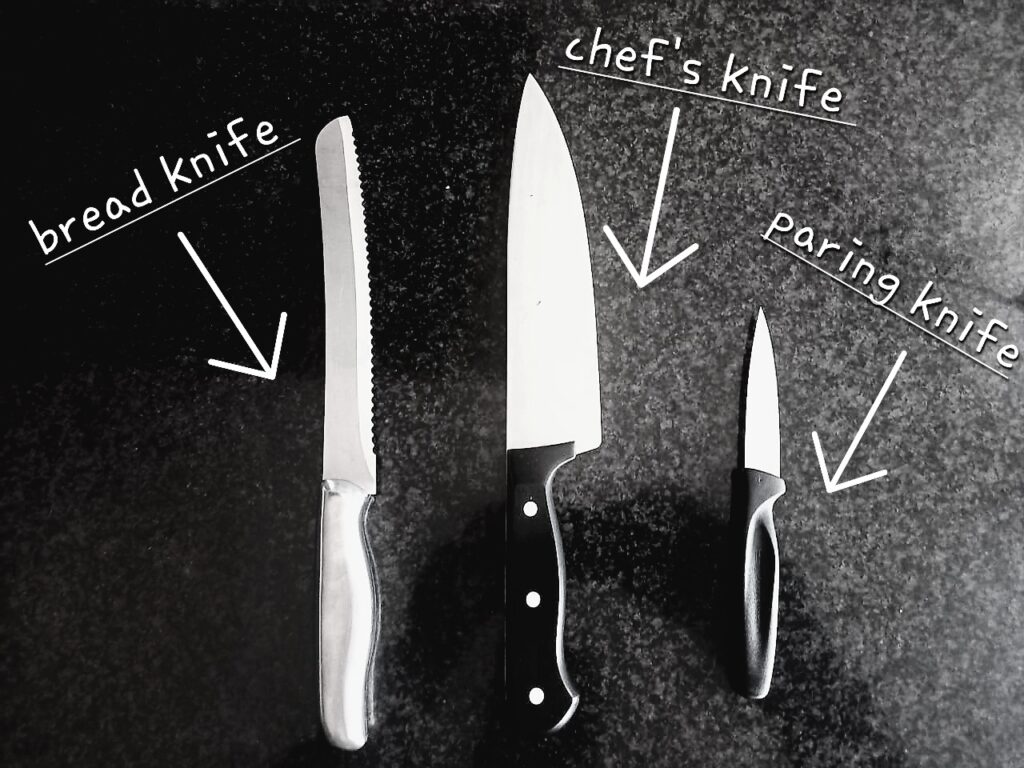
Your culinary school training teaches you:
- The specific purpose of each knife.
- The correct way to hold and use each knife.
- Knife safety.
- How to correctly care for, sharpen and store your knives.
Is culinary school hard?
Culinary school isn’t hard if you want to be there because you are passionate about cooking, willing to learn and work hard to master the theory and practical aspects of your culinary course, say chefs who have benefited from culinary school.
Culinary school programs have on-site training at the culinary school and apprenticeship or industry training in an off-site commercial kitchen. The on-site training received at the culinary school is, in comparison, easier to manage than the industry-based learning, which is more demanding as it is a real-life work situation necessary for holistic training.
We’ve compiled detailed guidelines chefs give to succeed at culinary school. Two significant ones include:
- Take responsibility for your culinary education by working hard and learning all you can on-site and in your industry-based learning.
- Develop a thick skin to criticism. You will make mistakes, which is part of learning. You may also be corrected in loud, sometimes angry tones. Develop resilience to this by separating the style of delivery from the message. In so doing, learn from the mistake and move forward.
How long is culinary school?
On average, a culinary education can take from one to three years. There are one-year, two-year, or three-year certificate, diploma and degree training courses.
There are shorter and part-time courses available. What is most important is to ensure that you are completing a national or internationally accredited course and that the course content qualifies you for what you would like to do in your culinary career.
What exams does a culinary student do?
A culinary student completes two types of exams: a theory and a practical exam. Over and above this, culinary students do an industry trade test. An exam like the City and Guilds or Highfield exam is conducted to qualify to work internationally.
The theory exam is a written exam and assesses whether the student has mastered a solid knowledge base in the technical aspects of preparing food, cooking, personal and kitchen health and safety, and kitchen management.
The practical exam is a hands-on exam that takes place in the lab kitchen of the culinary school, where the student must generate and plate a meal in a set time in line with the specific exam requirement. This can be preparing a two-course or three-course meal in an allotted time.
In addition, assignments must be completed.
Successful completion of the theory and practical exams prepares students and allows them to enter the industry-based learning phase of their culinary training.
How much does culinary school cost?
The average education cost across three renowned private culinary schools in the United States is about $34 323. A community school education in the United States costs significantly less than a private culinary school. A degree program at a community college can cost about $14 000, while that of a certificate can cost about $6 500.
Can I get a loan to go to culinary school?
Yes, you can get a loan to attend culinary school. This loan is usually obtained from a banking institution, and they will need specific information, such as proof of the following:
- Your acceptance into an accredited culinary school.
- that you are completing a recognised culinary course.
There are other options for funding your culinary education, of which bursaries are one; some culinary schools make bursaries available for students studying at their institution, so first enquire if this is so before seeking funding elsewhere.
Bursaries are also available from hospitality, food, and beverage institutions. In South Africa, for example, many such institutions offer bursary programs through the South African Chefs Association (SA Chefs), a body representing the culinary industry. Each institution, be it a hotel or restaurant, has eligibility requirements for bursary applicants, which you must comply with before applying.
Do you qualify as a chef after culinary school?
You qualify as a chef by completing an accredited culinary course with national certification. You start to work as a commis, entry-level chef and work your way up. To qualify as an international chef, you do an exam like the City and Guilds or Highfield after completing your culinary course.
Make sure of the specific requirements in your country. In South Africa, for example, you can only call yourself an occupational chef after completing an occupational trade test. This test is written whenever a student feels ready to do so. Generally, a more advanced culinary course of about three years prepares you for the trade test.
What does a culinary chef do?
A culinary chef specialises in cooking or baking. What defines a culinary chef, in addition to their skill in preparing and cooking food, is their flair for coming up with new food flavours, creating fresh meals, and plating them in visually appealing ways.
The roles and responsibilities of a culinary chef vary according to the chef level they occupy. This ranges from the food preparation and essential dishes done by the entry-level commis chef to managing the entire kitchen operations and staff, done by the highest-ranking executive chef.
The roles and responsibilities of a culinary chef also vary depending on the size of the food establishment in which they work. A culinary chef working as a commis chef in a tiny kitchen may have different roles and responsibilities than one working under an executive chef in a vast food establishment. In such a case, the commis chef is likely to be given responsibility beyond only food preparation.
Where do you find work after culinary school?
The scope for work in the culinary industry is extensive.
After culinary school, a job can be obtained in the hospitality industry, working for a private or hotel restaurant, the tourism industry working on a cruise ship, the healthcare industry, catering for hospitals or events catering companies.
An immediate place where you can find work after culinary school is where you completed your on-the-job training. Some of the chefs we spoke to mentioned that institutions often recruit culinary students who proved to be hard workers with a good attitude from the on-the-job-trainees.
Keeping a portfolio of evidence of your culinary projects is a great advantage when you are looking for work as a chef. This is a file with recipes you came up with and tested, dishes you created and plated in visually appealing designs at home, culinary school, or for competitions and events you participated in.
What culinary careers are available for a culinary chef?
There are two broad career options in culinary:
- Traditional, commercial kitchen-based careers as in a restaurant, following the commis to executive chef career path.
- Non-traditional or alternative culinary careers like a private chef or food journalist.
Within the traditional career path, you work your way up and transition through the chef hierarchy from bottom to top:
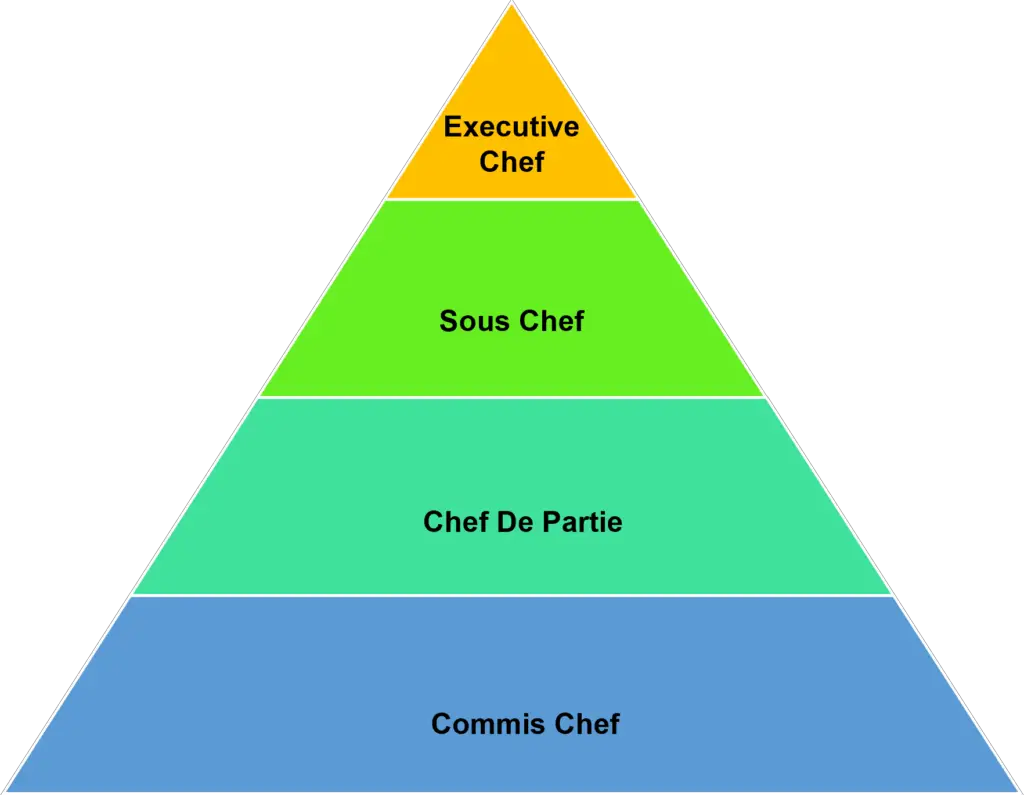
There are a variety of places you can work as a chef, operating on any of these levels.
Examples are working in:
- A fine dining restaurant, a cafe or a deli.
- Game ranches and wildlife parks.
- Airline catering.
- for corporate catering companies, to name a few.
Non-traditional, alternative culinary careers
These career paths offer alternatives to the more traditional chef career path. They can still be kitchen-based like that of the private chef. They can also be less kitchen-based like that the food photographer. The less kitchen-based careers are often referred to as out-of-the-kitchen culinary careers.
Many chefs start working in a traditional kitchen setup and later move on to other culinary career paths.
Examples of non-traditional culinary career paths include:
- Private yacht chef
- Food truck operator
- Food stylist
- Food product developer
- Food blogger
As a culinary chef, you can also become an entrepreneur and start your own catering company or restaurant or do freelance work as a food photographer, private chef on a yacht, or street food operator, for example.


